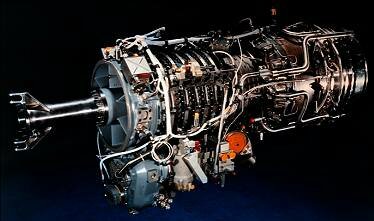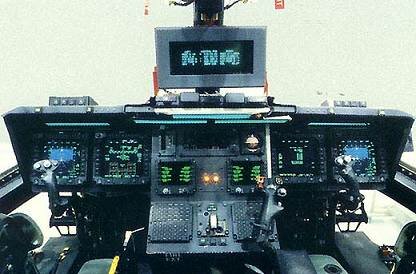Structure and Systems
Structure
The V-22's airframe is constructed primarily of graphite-reinforced epoxy composite material (by weight, 59% carbon fibre, 10% glassfibre, 20% metal and 11% other materials). The composite structure provides improved strength to weight ratio, corrosion resistance, and damage tolerance compared to typical metal construction. Battle damage tolerance is built into the aircraft by means of composite construction and redundant and separated flight control, electrical, and hydraulic systems.
The V-22 is fully shipboard compatible, with the world's first complete blade fold and wing stowage system. It is able to operate off all US Navy amphibious ships and assault carriers. For stowage, the wings are rotated to lie above and parallel to the fuselage to create a compact rectangular volume. The automatic wing and rotor folding sequence, which can be completed in 90 seconds in a 60-knot wind, is as follows: the aircraft lands in helicopter mode; the two outboard blades of each rotor are folded inboard; the nacelles are rotated forward to cruise mode; and the wings are rotated by 90 degrees clockwise.
The rear ramp allows easy access for wheeled vehicles and engine transport dollies. The internal floor can accommodate two 54x88-inch 463L half pallets, or four standard 40x48-inch cargo pallets.
Flight Control System
The Osprey uses a triple-redundant digital fly-by-wire flight control system for stability augmentation and improved handling qualities, and also to eliminate mechanical control complexity in the rotating wing stow mechanism. As this was a state-of-the-art system, the FSD Ospreys also featured an Analogue Backup Computer for flight controls. A triple-redundant 5000 psi (345 bar) hydraulic system does the work of moving the flight control surfaces. This high-pressure system required the use of expensive titanium and steel hydraulic lines, but it allowed smaller pumps and actuators, and smaller diameter tubes, for reduced weight.
The pilots have a central stick/cyclic, but in a major departure from helicopters the collective "power lever" was replaced by a pair of thrust control levers like those of the Harrier. Whether this was a good decision remains to be seen.
Crew
The V-22 is designed to be operated by a crew of two, pilot and copilot, situated side-by-side in the cockpit. Each crewmember has a complete set of controls necessary to fly the aircraft, and is seated in an armoured bucket seat made from boron carbide/spectra 1000B. In addition, each crew member is protected by an armored vest with the same ballistic rating as the seat armour.
The Marine Corps MV-22 has a folding crashworthy jumpseat for a third crew member mounted on the forward face of the cabin/cockpit door. The special operations CV-22 has a folding, crashworthy jumpseat with an extended seat pan allowing a flight engineer access to the center and overhead consoles.
The Osprey was designed to be able to carry 24 combat troops. In the casevac role, 12 litter can be carried.
Dimensions
| Rotor System | ||
| " Diameter | : | 38.00 ft (11.58m) |
| " Blade area | : | 261.52 ft2 (24.30 m2) |
| " Disc area | : | 2,268.00 ft2 (210.70 m2) |
| Dimensions - External | ||
| " Length | : | 57.3 ft (17.5m) |
| " Width, rotors turning | : | 83.33 ft (25.6m) |
| " Height, nacelles vertical | : | 21.8 ft (6.63m) |
| Dimensions - Folded | ||
| " Length | : | 62.6 ft (19.1m) |
| " Width | : | 18.5 ft (5.6m) |
| " Height | : | 18.1 ft (5.5m) |
| Dimensions - Internal | ||
| " Length | : | 24.17 ft (7.37m) |
| " Width | : | 5.92 ft (1.80m) |
| " Height | : | 6.00 ft (1.83m) |
| Weights | ||
| " Empty | : | 33,140 lb (15,032 kg) |
| " Takeoff, vertical | : | 47,500 lb (21,546 kg) |
| " Takeoff, STOL | : | 55,000 lb (24,948 kg) |
| " Takeoff, self-deploy | : | 60,500 lb (27,443 kg) |
| " Cargo hook, single | : | 10,000 lb (4,536 kg) |
| " Cargo hook, dual | : | 15,000 lb (9,221 kg) |
Engines
 The aircraft is powered by two Rolls-Royce AE 1107C-Liberty turboshaft engines rated at 4,586kW maximum continuous power (6150 shp). The engines are fitted with Lucas Aerospace full-authority digital electronic controls (FADEC), backup analog electronic control system, and fire protection systems. A transmission interconnect shaft provides single-engine operation. The thermal signature of the aircraft is minimised with an AiResearch infrared emission suppression unit, installed on the nacelles near the engine exhaust.
The aircraft is powered by two Rolls-Royce AE 1107C-Liberty turboshaft engines rated at 4,586kW maximum continuous power (6150 shp). The engines are fitted with Lucas Aerospace full-authority digital electronic controls (FADEC), backup analog electronic control system, and fire protection systems. A transmission interconnect shaft provides single-engine operation. The thermal signature of the aircraft is minimised with an AiResearch infrared emission suppression unit, installed on the nacelles near the engine exhaust.
The entire rotor, transmission and engine nacelles tilt through 90o in forward rotation and are directed forwards for forward flight, and through 7.5o in aft rotation for vertical take-off and landing.
Each engines drives a 11.6m (38 ft) diameter, 3-bladed proprotor. The proprotors are connected to each other by shafting which maintains proprotor synchronization and provides single engine power to both proprotors in the event of an engine failure. The engines and flight controls are controlled by a triply redundant digital fly-by-wire system. Blade tip speed is 661.90 ft/sec (201.75 m/sec).
In the event that the aircraft has to land with its rotors facing forward, the proprotor blades are designed to shred themselves. This is to avoid lumps of metal and plastic impacting the fuselage.
On takeoff the Marine Corps version's transmission handles 3408 kW (4570 shp), whereas the Navy and Air Force versions handle 3706 kW (4970 shp). In the engine-out condition the transmission can handle 4415 kW (5920 shp).
The V-22's fuel system is integrated into the wings and fuselage. The standard MV-22 configuration consists of five tanks: two feed tanks, two forward sponson tanks and the right aft sponson tank. This configuration holds 1448 US gallons (5480 liters). The CV-22 adds eight additional tanks, four in each wing, which increases capacity to 2040 gallons (7730 liters). Both variants can carry up to three auxiliary tanks in the cabin for self-deployment or ferry missions. Each of these holds 800 gallons (3032 liters).
Engine fuel is supplied by the left and right feed tanks to the adjacent engine. All other tanks transfer to these feed tanks and can also be cross-fed to the opposite feed tank. Fuel transfer operations are automatic, although some functions can be controlled by the pilot. The automatic transfer sequence empties the internal cabin tanks first if they are installed, the right aft sponson next, the wing tanks next and then both the left and right forward sponson tanks.
The V-22 fuel system is capable of supplying 30 minutes of fuel from the feed tanks to the engines with a complete loss of power to the Fuel Management Gauging System (FMGS).
All tanks are self-sealing against 12.7mm armour-piercing rounds. All fuel cell ullages are protected from explosion due to ballistic impacts by use of onboard inert gas generating system (OBIGGS), which provides inerting nitrogen-enriched gas to the feed cells and sponsons.
Avionics
An integrated electronic warfare defensive suite including a radar warning receiver, a missile warning set, and a countermeasures dispensing system, will be installed.
The US Air Force and US Navy variants are equipped with a Raytheon AN/APQ-186 terrain-following, multi-mode radar. The helicopter night-vision system is the Raytheon AN/AAQ-16 (V-22) FLIR, which is mounted on the nose. This system contains a 3-5 micron indium antimonide staring focal plane array.
The aircraft's electronic warfare suite includes Lockheed Martin's AN/AAR-47 missile warning system, which consists of four electro-optic sensors with photomultipliers, a signal processing unit and a cockpit display. The aircraft is also equipped with a radar and infrared threat warning system and chaff and flare dispensers with 60 rounds of dispensables.
The CV-22 will have the Suite of Integrated Radio Frequency Measures (SIRFC), being developed by ITT Avionics, and the AAQ-24(V) directional infra-red countermeasures system (DIRCM), which is made by Northrop Grumman Defensive Systems.

Osprey cockpit
Performance
| " Max speed, SL | : | 275 kt (510 km/h) |
| " Cruise speed, SL | : | 240 kt (436 km/h) |
| " Vert climb rate, SL | : | 1,090 ft/min (332 m/min) |
| " Max climb rate, SL | : | 2,320 ft/min (707 m/min) |
| " Service ceiling | : | 26,000 ft (7,925 m) |
| " Service ceiling (single engine) | : | 11,300 ft (3,444 m) |
| " Hover OGE | : | 14,200 ft (4,328 m) |
| " Amphibious assault | : | 515 nm (954 km) |
| " Max self-deployment | : | 2,100 nm (3,892 km) |
Weapons
MV-22s deployed to Iraq carry ramp-mounted .50-calibre machine guns, but this configuration limits the weapon to firing on only rearward targets.
In January 2008 BAE Systems was selected to adapt a remotely operated minigun for use on USAF CV-22s. The 7.62mm-calibre weapon is officially labeled as an "interim all-quadrant defensive weapon", but would be the first weapon system to be embedded within the internal structure of a V-22 airframe.
| <<< Origins | Top | Development >>> |
